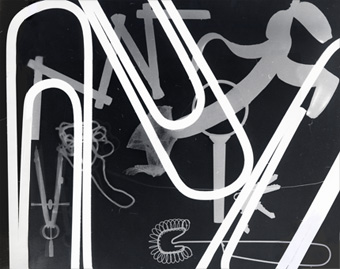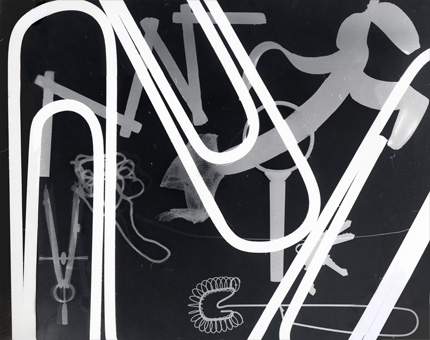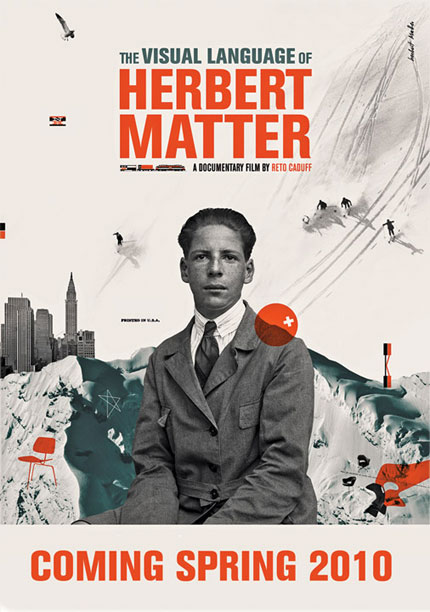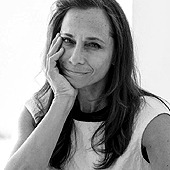
October 27, 2009
All Things Matter

Over a quarter of a century ago, I stood with a scattering of students in the smallest of darkrooms, huddled by an enlarger on whose surface sat a variety of extraneous objects. The room was silent, save for the occasional puffy breath of our professor, whose graceful hands rearranged things — a kitchen whisk here, a banana peel there — while we looked on, utterly captivated.
All at once there was a sudden burst of light exposure, before the room was once again bathed in total darkness. We listened as a sheet of photographic paper was pulled from beneath its impromptu still-life. Ever silent, our teacher escorted the paper through its solemn bathing ritual — from developer to stop bath to fixer — before clipping it with a clothespin onto a thin wire suspended over our heads.
He switched on the safelight as we gazed, transfixed, at the picture magically appearing before our eyes. “And so, you can see,” he began, in halting, heavily-accented English, “zees is how vee make za photogram.”
He looked at us all with a little half–smile. “Again?”
The ash from his ever-present cigarette floated onto the floor, as another sheet of paper was extracted from its thin Ilford box, and the process repeated itself, over and over and over. There was no talking. There was no discussion. There was only this kind of silent, impromptu shape-shifting, as our teacher positioned a series of inanimate objects and we looked on, studying his every move.
His name was Herbert Matter. He was a designer and a photographer, a teacher and an artist, a disciple of Alexey Brodovich, a friend to Alberto Giacometti, and a man even the ornery Paul Rand described as possibly the least pompous person on the planet. Matter, who died in 1984, was a professor at Yale for more than 20 years.
At the time he taught me how to make a Photogram, he was 74 years old.
It was an extraordinary thing to sit there and watch this magical process, though in truth it wasn’t until many years later that I realized what a critical moment this was for me personally, because it marked my true initiation into something which was, at the time, acutely foreign to me: the language of abstraction.

Curiously, while we were expected to hone our ability to engineer form, there was a sort of implicit assumption that we were expected to keep to the plan — a plan that only accepted certain kinds of form as, well, plausible. Just as we availed ourselves of a rather classical, even restrictive menu of typefaces to work with, so, too, were our compositional impulses expected to remain in check. If we were to divest ourselves of such notions, we were counseled to proceed with extreme caution, for to deviate from the canon was to give way to a kind of random, willy-nilly world of questionable outcome. And that was not graphic design.
Until those photograms came along, I had no idea that abstraction could literally make my pulse race. I came from a family of collectors and historians, where there was (still is) a premium on logic and narrative and clear communication. The idea that something gestural could, at once, infiltrate your brain with one story and whimsically attack your other senses with another was simply astonishing to me. How, after all, could you explain it? How could you define it? And how, in all honesty, could you possibly teach it?
I was mesmerized by photograms not only because the objects in play were real and recognizable, but because of the way they behaved, a series of oddly disenfranchised shapes that challenged the eye and by conjecture, the mind. They were dynamic, these images — compositionally irregular and physically compelling, with shadow where line should have been, and tricky overlapping edges making you rethink what, for example, constituted a foreground? Lines brushed against dots, which read as musical notes dancing across the surface of the paper. There were infinite shades of grey, and the possibility for even more, but more spectacular still than any of this was the fact that these fractured forms were incapable of duplication: they were one-offs, idiosyncratic and mysterious and unique. They couldn’t be codified because they possessed no intrinsic code. Unlike the principles which had come to define my design education, the photogram comprised no such rules, and inhabited a space with no clear definition, no certain boundaries.
I was in love.
Of course, although it would take me a long time to realize it, abstraction had everything to do with graphic design, but it was — and is — hard won. Having spent the first half of my life struggling to free myself from the constraints that constitute “good” design — the legibility and clarity of intent, the consistency that by definition embraces, say, responsible communication — I now find myself more and more drawn to the mystery of abstract form because, in the end I suppose, it is more haphazard and unpredictable, more organic and emotional, more human and, to me at least, more a reflection of a kind of basic, if complex, human truth. (Life is messy. So is abstraction.) When I look at the photograms we made that day, I remember all over again why I became a designer. And I owe it all to a soft-spoken, Swiss teacher of mine, who showed me that principles are not the same as rules; that two dimensions can so easily gesture to three; and that even though what we make as designers is by definition meant to be duplicated, we need never, ever, ever repeat ourselves. Which is a lesson that, even now, bears repeating.
Observed
View all
Observed
By Jessica Helfand
Related Posts

Graphic Design
Sarah Gephart|Essays
A new alphabet for a shared lived experience

Arts + Culture
Nila Rezaei|Essays
“Dear mother, I made us a seat”: a Mother’s Day tribute to the women of Iran

The Observatory
Ellen McGirt|Books
Parable of the Redesigner

Arts + Culture
Jessica Helfand|Essays
Véronique Vienne : A Remembrance
Recent Posts
Compassionate Design, Career Advice and Leaving 18F with Designer Ethan Marcotte Mine the $3.1T gap: Workplace gender equity is a growth imperative in an era of uncertainty A new alphabet for a shared lived experience Love Letter to a Garden and 20 years of Design Matters with Debbie MillmanRelated Posts

Graphic Design
Sarah Gephart|Essays
A new alphabet for a shared lived experience

Arts + Culture
Nila Rezaei|Essays
“Dear mother, I made us a seat”: a Mother’s Day tribute to the women of Iran

The Observatory
Ellen McGirt|Books
Parable of the Redesigner

Arts + Culture
Jessica Helfand|Essays

 Jessica Helfand, a founding editor of Design Observer, is an award-winning graphic designer and writer and a former contributing editor and columnist for Print, Communications Arts and Eye magazines. A member of the Alliance Graphique Internationale and a recent laureate of the Art Director’s Hall of Fame, Helfand received her B.A. and her M.F.A. from Yale University where she has taught since 1994.
Jessica Helfand, a founding editor of Design Observer, is an award-winning graphic designer and writer and a former contributing editor and columnist for Print, Communications Arts and Eye magazines. A member of the Alliance Graphique Internationale and a recent laureate of the Art Director’s Hall of Fame, Helfand received her B.A. and her M.F.A. from Yale University where she has taught since 1994.